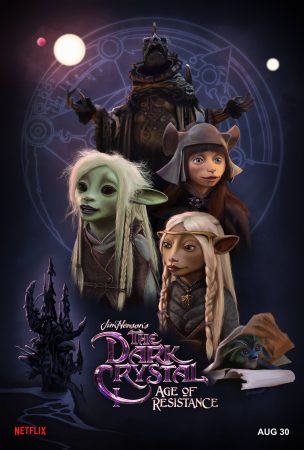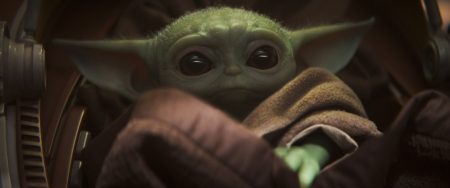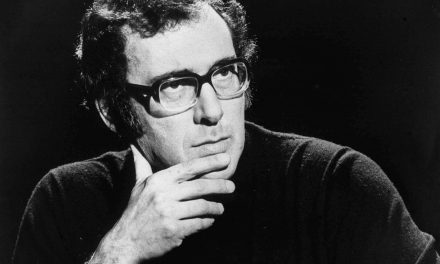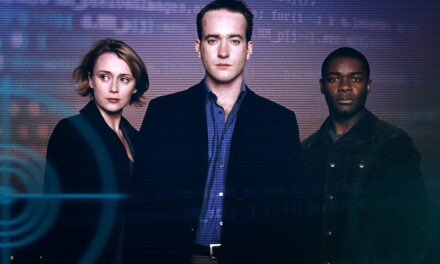In 2016, Netflix committed to “doubling down on kids and families” [1] through increased child and family-oriented Originals [2]. Netflix’s most successful and well-known Original series, Stranger Things, (2016- ) significantly contributed to the creation of a new middle ground of shared family viewing in the subscription-video-on-demand (SVOD) ecology, in which Netflix resists broadcast TV approaches to family audiences. This influenced the evolution of the contentious new Netflix micro-genre “Family Watch Together TV,” which encompasses family-oriented science fiction, horror and fantasy. In turn, Disney+’s launch campaign was anchored to its flagship Original, the family-oriented but violent Star Wars series The Mandalorian (2019-). Through these key texts and genres, Netflix and Disney+ are consolidating a new dark family terrain in the streaming sector that unsettles traditional paradigms of family viewing.
Netflix launched its “Family Watch Together TV” micro-genre tag the year after Stranger Things. Showrunners and creators, the Duffer brothers, claim Stranger Things was rejected 15 to 20 times by various television networks, with the networks suggesting the series would only be suitable for broadcast if the content and focus were made more suitable for children, or if it was re-positioned as an explicitly adult-oriented show [3]. Rejecting this demand to tailor the series to a broadcast TV-era vision of the family demographic, the Duffer brothers sold the concept to Netflix. Despite a US rating of TV-14, the plethora of child-oriented merchandise around Stranger Things — such as child-sized t-shirts — suggests a broader reach, even if Netflix remains characteristically cagey about its viewing data. Since the debut of Stranger Things, there has been a continuous stream of commentary about whether younger children should be allowed to watch the program with their families [4].
Following on from Stranger Things, Netflix’s new “Family Watch Together TV” micro-genre tag continues to challenge cultural expectations around family-oriented television, even at the lower classification of TV-PG. Indeed, the first program with the “Family Watch Together TV” tag, the acerbic and fantastical A Series of Unfortunate Events (2017-2019), admonishes viewers in its theme song to “look away” given “there’s nothing but horror” in the program. Netflix followed with a suite of “Family Watch Together TV” programs that delve into dark fantasy, horror and science fiction territory, including Lost in Space (2018 – ) The Dark Crystal: Age of Resistance (2019 -) and Raising Dion (2019 – ). “Family Watch Together TV” reconfigures earlier approaches to the “so-called ‘family audience’,” which “symbolised respectability, profitability and mass cultural acceptance” [5]. Netflix and other SVOD platforms are able to reject such legacy media practices around family audiences due to the personalised, on-demand rather than mass broadcast model of SVODs, and the relative freedom of SVOD platforms from regional, age-based classification frameworks. For instance, Netflix self-classifies its content [6], and the “Family Watch Together TV” tag is displayed far more prominently on the platform than classifications. Such display strategies are a way of downplaying stricter international standards, such as in Australia where Lost in Space and Age of Resistance were given the more teen-oriented rating of M. These discrepancies suggest that outside the “kids” profiles, adhering to classifications is not as important to SVODs as capturing the family market.
Netflix’s “Family Watch Together TV” tag illuminates much about how SVOD services approach family-oriented content and audiences. Rather than targeting families via content aimed at a broad demographic which is unambiguously positioned as suitable for children, this micro-genre often self-reflexively reboots children’s media from the past to invite parental nostalgia. This encourages parents not only to introduce the programs to their children, but also to be highly invested in watching it with them. Matt Hills reflects upon becoming a fan of Doctor Who (BBC 1963-1989, 2005-) through his father’s enthusiasm for the program, calling it a type of “associative contagion” [7]. Through series like Lost in Space – a reboot of the 1965-1968 program – Netflix actively courts such “associative contagion” by inviting affective connections between nostalgic older viewers and their children or grandchildren. Lost in Space is part of what Kathryn Pallister et al call Netflix Nostalgia [8], however, such efforts are only nostalgic from the perspective of viewers old enough to remember the originals. “Family Watch Together TV” tends to solicit a specific intergenerational dynamic between older fans and younger viewers as future subscribers.

Fig. 3: The Dark Crystal: Age of Resistance (2019-). Image from 2-px.
Such encouragement of shared intergenerational consumption is evidenced most recently in Netflix’s “Family Watch Together TV” program The Dark Crystal: Age of Resistance (2019-), rated TV-PG. The series, which has regularly been dubbed “Game of Thrones with puppets” [9], is a dark and violent puppet-animated high fantasy. Like Lost in Space, Age of Resistance invites intergenerational dialogue and “contagion” via a complex engagement with the nostalgia of parents. Age of Resistance is a prequel series to Jim Henson and Frank Oz’s cult 1982 puppet-animated dark fantasy film The Dark Crystal. Notably, cultural nostalgia for The Dark Crystal is grounded in the film’s notoriety for frightening 1980s child audiences. This haunted nostalgia is a core theme of the media commentary surrounding the Netflix show, indicating that it is key to the show’s allure. Commentators like Beth Elderkin celebrate the film’s scarring emotional impact on a generation of children, while praising the potential of Netflix’s series to distress contemporary child audiences in a similar way. Elderkin notes that while the show is dark, grim and often violent, “that doesn’t mean [it] isn’t for children. . . Sure it’s dark, but it’s healthy to introduce complex stories like this to children” [10].

Fig. 4: ‘Baby Yoda’ in The Mandalorian (2019-). Image from VanityFair.
In turn, Disney+ has repositioned its family-friendly brand by aligning its flagship television program with this dark intergenerational terrain initiated by Netflix’s “Family Watch Together TV.” Disney+’s flagship Original, The Mandalorian, was hailed as “the biggest new TV show from the big new platform of the biggest media conglomerate, set within arguably America’s biggest pop mythology” [11]. The program’s success established child and family audiences as a key site of competition between established market leader Netflix and newcomer Disney+. In November 2019, The Mandalorian (G in Japan, TV-PG in the US, and M in Australia) overtook Stranger Things to become the most in-demand streaming series, “a strong indication that the Star Wars series is driving a lot of sign-ups to the fledgling Disney+ service” [12]. The Mandalorian encourages intergenerational modes of audience engagement in similar ways to the Netflix Originals, harnessing both the Star Wars and Disney brands’ ongoing associations with children’s culture, while appealing to multiple generations of adult Star Wars fans.
Emblematic in this respect is “Baby Yoda,” a largely puppet-animated character who references Star Wars history but also evokes the dark fantasy puppet work of Jim Henson, as well as the disruptive child-like alien trope long central to family sci-fi, from E.T. (Steven Spielberg 1982) to Lilo & Stitch (Chris Sanders & Dean DeBlois 2002). The Mandalorian, like Netflix’s family micro-genre, engages with adult nostalgia to encourage adult guardians to introduce their children to a fantasy world that veers into darker, more violent territory than is usual in family-oriented broadcast television content.
Ambiguity and ambivalence around The Mandalorian’s family orientation are articulated on Common Sense Media, a popular US-based recommendation site for families. After its first three weeks of release, the child reviewers on the site downplayed the violence in The Mandalorian, labelling the series “pretty tame,” “fun,” “just great” [13], albeit with a “couple of possibly scary creatures, but that’s Star Wars for ya” [14]. The Mandalorian’s family-friendly status was categorically asserted by an 11-year-old reviewer, who classified the serial in their review title as, “Family friendly and not too violent” [15]. Some parent reviewers, by contrast, expressed concern about the series’ violent content and tone, chastising the “star wars [sic] style of violence” and “creepy” tone [16], and suggesting that “Children under 14 will want to continue watching this and they will see the violence over and over again desensitizing them to murder” [17]. Highlighting this contrasting cultural reception, the overall rating and age suitability from the twelve “kid” reviewers on the site were 5 stars and 9+ respectively. By contrast, the fifteen adult reviewers gave the serial a rating of 4 stars and a suitability classification of 11+.
Netflix’s dark fantasy offerings under the “Family Watch Together TV” micro-genre tag occupy a different textual and cultural space than earlier, legacy media conceptions of the family audience outlined by Brown [18] and others. As Disney+ now competes for “family” customers by marketing shared intergenerational consumption of dark fantasy, the boundaries of what constitutes the new model of family viewing are still much contested.
Djoymi Baker is a Lecturer in Media and Cinema Studies at RMIT University, Australia. She is a prize-winning writer on topics such as genre studies, fandom and myth in popular culture. Djoymi is the author of To Boldly Go: Marketing the Myth of Star Trek (I. B. Tauris, 2018) and the co-author of The Encyclopedia of Epic Films (Rowman & Littlefield, 2014). Her current research examines children’s film and television history.
Jessica Balanzategui is a Lecturer in Cinema and Screen Studies at Swinburne University of Technology and a Chief Investigator at the Centre for Transformative Media Technologies. Her research examines screen genres across film, television and digital media for and about children, and the impact of technological and industrial change on entertainment cultures. Jessica is the author of The Uncanny Child in Transnational Cinema (Amsterdam University Press, 2018), and the founding editor of Amsterdam University Press’s book series, Horror and Gothic Media Cultures. Jessica is also an editor of Refractory: A Journal of Entertainment Media.
Diana Sandars is a Lecturer in the School of Culture and Communication at the University of Melbourne, Australia, where she teaches courses in Screen, Gender, Digital Cultures, Social Justice and Cultural Studies. Diana has a research focus on the child in, and subject of, screen media. Diana is the author of What A Feeling: The Hollywood Musical After MTV (Intellect, forthcoming).
References
Brown, Noel. 2013. ‘A New Movie-going Public’: 1930s Hollywood and the Emergence of the ‘Family’ Film. Historical Journal of Film, Radio and Television 33(1), pp 1 – 21.
Cantor, Muriel. 1991. The American Family on Television: From Molly Goldberg to Bill Cosby. Journal of Comparative Family Studies 12(2), pp 205 – 216.
Common Sense Media. 2019. The Mandalorian. https://commonsensemedia.org/tv-reviews/the-mandalorian.
Elderkin, Beth. 2019. ‘The Dark Crystal: Age of Resistance’ is the Ground-breaking Fantasy Epic we’ve been waiting for. Gizmodo, 23 August, https://gizmodo.com.au/2019/08/the-dark-crystal-age-of-resistance-is-the-groundbreaking-fantasy-epic-weve-been-waiting-for/.
Flint, Joe. 2016.Netflix to Ramp Up Originals Targeting Kids. The Wall Street Journal, 17 January, https://wsj.com/articles/netflix-to-ramp-up-originals-targeting-kids-1453058812.
Grow, Kory. 2016. ‘Stranger Things’: How Two Brothers Created Summer’s Biggest TV Hit. Rolling Stone, 03 August, https://rollingstone.com/tv/tv-features/stranger-things-how-two-brothers-created-summers-biggest-tv-hit-105527/.
Hills, Matt.2002. Fan Cultures, London & New York: Routledge.
Hymas, Charles. 2019. Netflix to introduce official age classifications on all its films and shows. The Telegraph, 28 October, https://telegraph.co.uk/news/2019/10/28/netflix-introduce-official-age-classifications-films-shows/.
Littleton, Cynthia. 2017. Netflix to boost international kids content as viewership spikes. Variety, 15 October, https://variety.com/2017/tv/news/netflix-kids-guillermo-del-toro-trollhunters-andy-yeatman-1202590366/.
Lobato, Ramon. 2019. Netflix Nations: The Geography of Digital Distribution, New York: New York University Press.
Loussikian, Kylar. 2019. Netflix gets approval to classify own shows after two-year trial. Sydney Morning Herald, 20 January, https://smh.com.au/business/companies/netflix-gets-approval-to-classify-own-shows-after-two-year-trial-20190120-p50sim.html.
Milbrand, Lisa. 2017. I’m Binge Watching ‘Stranger Things’ With My Kids This Weekend. Should You? Parents, 30 October, https://parents.com/toddlers-preschoolers/everything-kids/im-binge-watching-stranger-things-with-my-kids-this-weekend/.
Pallister, Kathryn, ed. 2019. Netflix nostalgia: streaming the past on demand, Lanham, Maryland: Lexington Books.
Parrot Analytics. 2019. Television series audience TV demand in the U.S. (17 – 23 November, 2019). 25 November, https://parrotanalytics.com/insights/television-series-audience-tv-demand-in-the-u-s-17-23-november-2019/.
Poniewozik, James. 2019. Baby Yoda is Your God Now. What if the future of TV were delightful, irresistible, meme-able versions of intellectual property you already loved … forever? New York Times, 12 December (updated 16 December), https://nytimes.com/2019/12/12/arts/television/baby-yoda-mandalorian.html.
Renau, Annie. 2018. Is My Kid Old Enough To Watch That? The Ins & Outs Of Parental Guidance. Scary Mommy, 26 January, https://scarymommy.com/parental-controls-movie-ratings/.
Trenholm, Richard. 2019. Dark Crystal: Age of Resistance on Netflix is Game of Thrones with puppets. CNET, 1 September, https://cnet.com/news/magical-dark-crystal-age-of-resistance-netflix-review-game-of-thrones-with-puppets/.
Waterson, Jim. 2019. Netflix to set its own age ratings for film and television programmes. The Guardian, 14 March, https://theguardian.com/media/2019/mar/14/netflix-to-set-its-own-age-ratings-for-film-and-television-programmes.
Wetmore, Kevin. 2018. Stranger (Things) in a Strange Land, or I Love the ‘80s? in Wetmore (ed), Uncovering Stranger Things: Essays on Eighties Nostalgia, Cynicism, and Innocence in the Series, Jefferson, NC: McFarland. pp 1-7.
Wired. 2019. The Dark Crystal Prequel Is Game of Thrones With Puppets. 21 September, https://wired.com/2019/09/geeks-guide-dark-crystal/.
Notes:
[1] Ted Sarandos cited in Flint, Joe. 2016.Netflix to Ramp Up Originals Targeting Kids. The Wall Street Journal, 17 January, https://wsj.com/articles/netflix-to-ramp-up-originals-targeting-kids-1453058812.
[2] Littleton, Cynthia. 2017. Netflix to boost international kids content as viewership spikes. Variety, 15 October, https://variety.com/2017/tv/news/netflix-kids-guillermo-del-toro-trollhunters-andy-yeatman-1202590366/.
[3] Grow, Kory. 2016. ‘Stranger Things’: How Two Brothers Created Summer’s Biggest TV Hit. Rolling Stone, 03 August, https://rollingstone.com/tv/tv-features/stranger-things-how-two-brothers-created-summers-biggest-tv-hit-105527/.
[4] Milbrand, Lisa. 2017. I’m Binge Watching ‘Stranger Things’ With My Kids This Weekend. Should You? Parents, 30 October, https://parents.com/toddlers-preschoolers/everything-kids/im-binge-watching-stranger-things-with-my-kids-this-weekend/. Renau, Annie. 2018. Is My Kid Old Enough To Watch That? The Ins & Outs Of Parental Guidance. Scary Mommy, 26 January, https://scarymommy.com/parental-controls-movie-ratings/.
[5] Brown, Noel. 2013. ‘A New Movie-going Public’: 1930s Hollywood and the Emergence of the ‘Family’ Film. Historical Journal of Film, Radio and Television 33(1), pp. 1 – 21. Cantor, Muriel. 1991. The American Family on Television: From Molly Goldberg to Bill Cosby. Journal of Comparative Family Studies 12(2), pp. 205 – 216.
[6] Hymas, Charles. 2019. Netflix to introduce official age classifications on all its films and shows. The Telegraph, 28 October, https://telegraph.co.uk/news/2019/10/28/netflix-introduce-official-age-classifications-films-shows/. Lobato, Ramon. 2019. Netflix Nations: The Geography of Digital Distribution, New York: New York University Press, pp. 3, 64. Loussikian, Kylar. 2019. Netflix gets approval to classify own shows after two-year trial. Sydney Morning Herald, 20 January, https://smh.com.au/business/companies/netflix-gets-approval-to-classify-own-shows-after-two-year-trial-20190120-p50sim.html. Waterson, Jim. 2019. Netflix to set its own age ratings for film and television programmes. The Guardian, 14 March, https://theguardian.com/media/2019/mar/14/netflix-to-set-its-own-age-ratings-for-film-and-television-programmes.
[7] Hills, Matt.2002. Fan Cultures, London & New York: Routledge, p. 58.
[8] Pallister, Kathryn, ed. 2019. Netflix nostalgia: streaming the past on demand, Lanham, Maryland: Lexington Books.
[9] Trenholm, Richard. 2019. Dark Crystal: Age of Resistance on Netflix is Game of Thrones with puppets. CNET, 1 September, https://cnet.com/news/magical-dark-crystal-age-of-resistance-netflix-review-game-of-thrones-with-puppets/. Wired. 2019. The Dark Crystal Prequel Is Game of Thrones With Puppets. 21 September, https://wired.com/2019/09/geeks-guide-dark-crystal/.
[10] Elderkin, Beth. 2019. ‘The Dark Crystal: Age of Resistance’ is the Ground-breaking Fantasy Epic we’ve been waiting for. Gizmodo, 23 August, https://gizmodo.com.au/2019/08/the-dark-crystal-age-of-resistance-is-the-groundbreaking-fantasy-epic-weve-been-waiting-for/.
[11] Poniewozik, James. 2019. Baby Yoda is Your God Now. What if the future of TV were delightful, irresistible, meme-able versions of intellectual property you already loved … forever? New York Times, 12 December (updated 16 December), https://nytimes.com/2019/12/12/arts/television/baby-yoda-mandalorian.html.
[12] Parrot Analytics. 2019. Television series audience TV demand in the U.S. (17 – 23 November, 2019). 25 November, https://parrotanalytics.com/insights/television-series-audience-tv-demand-in-the-u-s-17-23-november-2019/.
[13] Kid, Aged 12 (2019) The Mandalorian. Common Sense Media. https://commonsensemedia.org/tv-reviews/the-mandalorian/user-reviews/child.
[14] Logan90 (2019) The Mandalorian. Common Sense Media. https://commonsensemedia.org/tv-reviews/the-mandalorian/user-reviews/child.
[15] Kid, 11 years old (2019) The Mandalorian. Common Sense Media. https://commonsensemedia.org/tv-reviews/the-mandalorian/user-reviews/child.
[16] PCpancake (2019) The Mandalorian. Common Sense Media. https://commonsensemedia.org/tv-reviews/the-mandalorian/user-reviews/adult.
[17] Kristicoolj (2019) The Mandalorian. Common Sense Media. https://commonsensemedia.org/tv-reviews/the-mandalorian/user-reviews/adult.
[18] Brown, Noel. 2013. ‘A New Movie-going Public’: 1930s Hollywood and the Emergence of the ‘Family’ Film. Historical Journal of Film, Radio and Television 33(1), pp 1 – 21.







Thank you all so much for another fascinating item to read which leaves me more informed about an aspect of television watching which I feel very fond of, and which also gives me a few more titles to watch out for in the years to come so that I can join in the fun as well. As yet, I hear great things about shows like “Stranger Things” but have simply not had chance to experience it ourselves. And after seeing a presentation about “The Dark Crystal: Age of Resistance” a few months back, we can’t wait for it to arrive on a screen near us.
Particularly interesting to read how shows like “Lost in Space” were rated in Australia; I’ve always found the certification system fascinating when applied to British shows that I’m familiar with, and seeing examples of what material does or doesn’t meet certain criteria – mainly because it helps me to understand the differences of approach to similar audiences in two different territories.
Thanks for a piece which gives me valuable reading. Much appreciated!
All the best
Andrew
This was a great blog, thank you. I’m interested in your point about intergenerational dynamics (older fans and younger viewers) — do you think this is specific to dark fantasy or a broader family viewing trend? It’s fascinating how Netflix and Disney+ seem to be applying it in different ways.
I’d love to read an expanded version of your arguments, I’ll keep an eye out for your publication(s)!
Thank you for your insightful feedback. Looking at the titles currently offered under “Family Watch Together TV” here in Australia, we think an argument could be made that the sequel series Fuller House (2016-), along with the remakes Anne with an E (2017-2019) and One Day at a Time (Netflix 2017-2019, PopTV 2020-), seem to encourage an intergenerational dynamic of older fan and younger viewer, though the way that plays out varies across texts and genres.
While we didn’t have room to go into it for this article, telefantasy has a long history of troubling the way we think about family audiences (as you would know, Filipa – we are fans of your great work on the children’s horror film!), and we think this ‘troubled’ and ‘troubling’ history is continued yet reworked in the SVOD era. The Netflix “Family Watch Together TV” dark fantasy offers a family viewing experience that intersects with a more specific “haunted” nostalgia around creepy and violent content that parents and commentators are finding particularly unsettling.
It’s probably worth nothing that even if Netflix released its audience data, those famous algorithms can’t reveal whether families are actually watching these programs together. So beyond the textual content of Netflix’s dark fantasy family shows – which often feature fractured families under attack – we’re also interested in Netflix’s marketing of a different notion of family viewing, compared with social media reception where adults frequently contest their suitability for families.
Best,
Djoymi, Jessica and Diana